Information about the Sweedler Research Group.
 In the Sweedler Research Group, we work on a broad array of projects that span analytical chemistry and chemical biology to neuroscience and bioengineering. We conduct research in bioanalytical chemistry and focus on the development of analytical methods for assaying complex microenvironments, including capillary electrophoresis separations, laser-based detectors, MALDI sampling techniques, and nanoliter volume NMR.
In the Sweedler Research Group, we work on a broad array of projects that span analytical chemistry and chemical biology to neuroscience and bioengineering. We conduct research in bioanalytical chemistry and focus on the development of analytical methods for assaying complex microenvironments, including capillary electrophoresis separations, laser-based detectors, MALDI sampling techniques, and nanoliter volume NMR.
In addition to these information-rich approaches, new methodologies based on micro/nanofluidic sampling and single-cell isolations are used. Applying these techniques, we examine a range of neurochemical pathways in a variety of organisms. Studies include the distribution, metabolism, and dynamic release of neuropeptides and classical transmitters in a cell-specific manner. We are especially interested in the roles that such neuromodulatory compounds play in behavior, learning, and memory.
The development of novel toolsets enables new measurements that drive scientific advances. Just as important is the use of well-chosen animal models that cross the scale of simple to complex. Combining these two areas, we are advancing our understanding of new neurochemical pathways and brain function. You will find web pages on the techniques, the neurochemical pathways, and the models that we study.
Our Principal Investigator is Johnathon V. Sweedler.
Scroll down and check the tabs below or our website here to learn more.
 Our group works on a range of projects to improve analytical measurement technology, in most cases, pushing them to higher performance with smaller samples. The need to sample small volumes is obvious when working with single cells and subcellular domains. Thus, significant efforts use techniques with favorable scaling laws for low-volume samples. Capillary separations are well suited to working with small volume samples, as is mass spectrometry. Other approaches investigated include nanoliter volume NMR, microfluidics and microscopy. One goal is to develop approaches that achieve greater chemical information while obtaining either temporal or spatial information.
Our group works on a range of projects to improve analytical measurement technology, in most cases, pushing them to higher performance with smaller samples. The need to sample small volumes is obvious when working with single cells and subcellular domains. Thus, significant efforts use techniques with favorable scaling laws for low-volume samples. Capillary separations are well suited to working with small volume samples, as is mass spectrometry. Other approaches investigated include nanoliter volume NMR, microfluidics and microscopy. One goal is to develop approaches that achieve greater chemical information while obtaining either temporal or spatial information.
Measurements in neuroscience require greater sensitivity and improved information content, with a higher-throughput and massively-parallel character, areas we address in our metabolomic and peptidomics efforts. While we use other approaches in the group, our technology development efforts are highlighted and described in the following major areas:
Capillary Electrophoresis (CE)
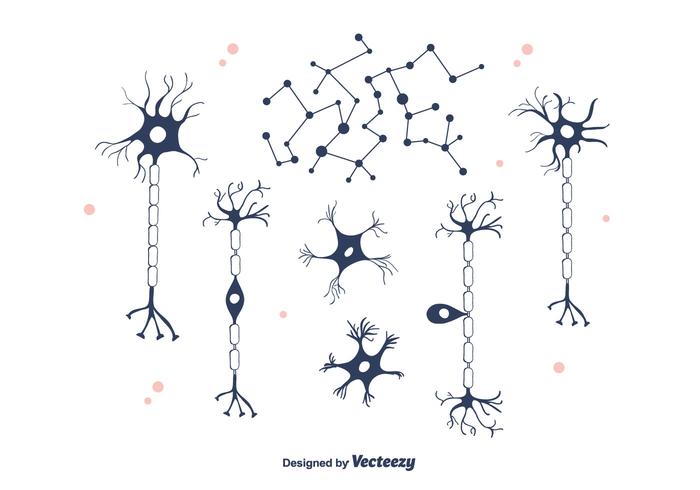 Capillary electrophoresis (CE) is uniquely suited to the analysis of cellular samples due to the small inner diameter of typical capillaries (5-100 microns), which are well-matched to the size of isolated neurons (5-500 microns). The use of small capillaries leads to improved mass sensitivity and faster separations.
Capillary electrophoresis (CE) is uniquely suited to the analysis of cellular samples due to the small inner diameter of typical capillaries (5-100 microns), which are well-matched to the size of isolated neurons (5-500 microns). The use of small capillaries leads to improved mass sensitivity and faster separations.
Multiple detection schemes are utilized in the Sweedler research group, including offline coupling of CE to MALDI-MS, absorbance, and laser-induced fluorescence (LIF) of both natively fluorescent and derivatized molecules. LIF is a sensitive detection method for CE of cellular samples with detection limits in the attomole range for many small molecules.
Current CE projects include:
- Improving Cell Sampling using Optical Trapping
- Enhancing Native Fluorescence Detection
- Interfacing CE with Mass spectrometry for Single Cell Measurements
- Measuring Nitric Oxide and Nitric Oxide-Related
- Compounds in Neurons
- Understanding Serotonin Catabolism
- Examining the Distribution, Release and Biosynthesis of D-Amino Acids
Mass Spectrometry (MS)
Because of its high throughput, sensitivity, and chemical information content, mass spectrometry is well-suited to characterizing mass limited complex samples. Experiments are often performed using multiple stages of separation, but also involve direct tissue profiling. The ability of a mass spectrometry system depends on the sample ionization approach and the details of the mass analyzer. The Sweedler group owns multiple mass spec instruments: a Bruker ultra-extreme MALDI-TOF/TOF mass spectrometer and six electrospray instruments, including a Bruker maXis 4G tandem Qq-TOF mass spectrometer (80,000 resolution), a Bruker Impact HD Qq-TOF (50,000 resolution), a Bruker ion trap amaZon Speed ETD (20,000 resolution), a Bruker micrOTOF Benchtop ESI-TOF mass spectrometer (interfaced to a home-built capillary electrophoresis system), a Bruker EVOQ Elite triple quadrupole, and an ABI QSTAR with interchangeable ESI & MALDI sources that has also been adapted to work with a C60 ion source in SIMS mode.
More information on mass spectrometry, including the types of instruments, can be found at http://www.asms.org/about/about-mass-spectrometry.
Current MS-related projects include:
Sampling
While capillary separations, mass spectrometry, NMR and other techniques offer unprecedented chemical information content, the success of the measurement depends on the methods used to sample the materials. We are developing a range of approaches to measure the environment around a neuron and even neuronal subcompartments, as well as to control this environment. These engineered structures allow mass limited sampling in a variety of contexts ranging from measuring the peptides released from a brain slice at a specific time of day to encouraging two neurons to connect within a microfluidic device and measuring the extracellular media after a specific stimulation. In addition, aspects of this research are aimed at enhancing our fundamental understanding of fluid flow and the operation of such nanofluidic/microfluidic devices.
Current Sampling projects include:
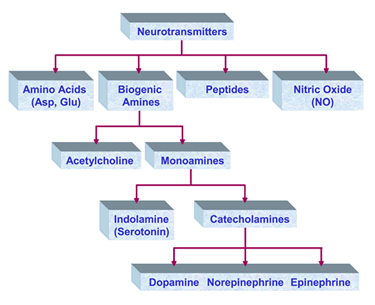 Cell to cell communication in the brain uses a diverse set of molecules, ranging from gaseous molecules such as nitric oxide (NO), classical transmitters such as glutamate, surprising molecules such as d-serine and a range of peptides. The Sweedler group studies these to understand how networks of neurons and associated supporting cells such as glia can work together to yield emergent properties that give rise to behaviors and memory. Specific questions address what molecules are present in specific cells and networks, how they change based on behavior or exposure to drugs, as well as their function.
Cell to cell communication in the brain uses a diverse set of molecules, ranging from gaseous molecules such as nitric oxide (NO), classical transmitters such as glutamate, surprising molecules such as d-serine and a range of peptides. The Sweedler group studies these to understand how networks of neurons and associated supporting cells such as glia can work together to yield emergent properties that give rise to behaviors and memory. Specific questions address what molecules are present in specific cells and networks, how they change based on behavior or exposure to drugs, as well as their function.
Several of the projects we are most involved with are:
Measuring Nitric Oxide and Nitric Oxide-Relate Compounds in Neurons
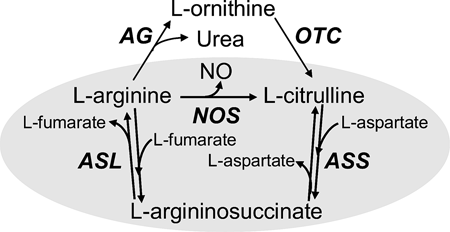 Nitric oxide (NO), a gaseous signal molecule, is involved in a variety of important biological functions in the cardiovascular system, the central and peripheral nervous system, the reproductive and the immune system. NO is typically generated through enzymatic conversion of arginine (Arg) to citrulline (Cit) by NO synthase (NOS). In addition to enzymatically produced NO, there may be another source of NO in neuronal tissues containing high levels of nitrite and ascorbate. Our group has been trying to understand these enzymatic and enzyme-independent NO production mechanisms chemically, temporally and spatially. Our model systems are functionally characterized and identified neurons of Aplysia californica, Pleurobranchaea californica, and Lymnaea stagnalis - three well-recognized models in cellular and system neuroscience. Capillary electrophoresis with laser-induced fluorescence detection (CE-LIF) is our method of choice, which is well-suited for the analysis of individual cells, primarily because of the high separation efficiencies, ultra-small-volume sample requirements, and sensitive detection methods associated with the technique.
Nitric oxide (NO), a gaseous signal molecule, is involved in a variety of important biological functions in the cardiovascular system, the central and peripheral nervous system, the reproductive and the immune system. NO is typically generated through enzymatic conversion of arginine (Arg) to citrulline (Cit) by NO synthase (NOS). In addition to enzymatically produced NO, there may be another source of NO in neuronal tissues containing high levels of nitrite and ascorbate. Our group has been trying to understand these enzymatic and enzyme-independent NO production mechanisms chemically, temporally and spatially. Our model systems are functionally characterized and identified neurons of Aplysia californica, Pleurobranchaea californica, and Lymnaea stagnalis - three well-recognized models in cellular and system neuroscience. Capillary electrophoresis with laser-induced fluorescence detection (CE-LIF) is our method of choice, which is well-suited for the analysis of individual cells, primarily because of the high separation efficiencies, ultra-small-volume sample requirements, and sensitive detection methods associated with the technique.
Neuropeptidomics: Characterizing Peptides in the Brain
 Neuropeptidomics is a fairly recent term that indicates the global measurement and identification of the complement of peptides in a cell, tissue, or extracts from the brain or nervous system tissue. Obviously, peptide measurements have a much longer history, but the ability to approach global characterization and generation of lists of literally hundreds of peptides from a tissue represents a change in scale of such efforts.
Neuropeptidomics is a fairly recent term that indicates the global measurement and identification of the complement of peptides in a cell, tissue, or extracts from the brain or nervous system tissue. Obviously, peptide measurements have a much longer history, but the ability to approach global characterization and generation of lists of literally hundreds of peptides from a tissue represents a change in scale of such efforts.
We measure the peptides in a range of cell types such as glia and neurons, and animal models. For example, neuropeptide genes are difficult to annotate and so we are working with several genome efforts to discover the neuropeptides in important model organisms. This also allows us to follow the development of neuropeptide families across diverse phyla, and with semi-quantitative measurements, to determine which peptides change depending on exposure to drugs of abuse or behavioral state.
Peptidomics projects:
- Improving prohormone processing prediction with bioinformatics
- Enhancing peptide characterization using FT-MS
- Extracting and measuring the peptides
- Relative quantitation of peptide levels
Characterizing new neuropeptide genes and peptides in the following animal models:
- Sea slug: Aplysia
- Honey bee: Apis
- Ctenophore
- Planarian
- Sea urchin
- Songbird
- Mammals
- Glia peptidome
Studying the Distribution, Release, and Biosynthesis of D-Amino Acids
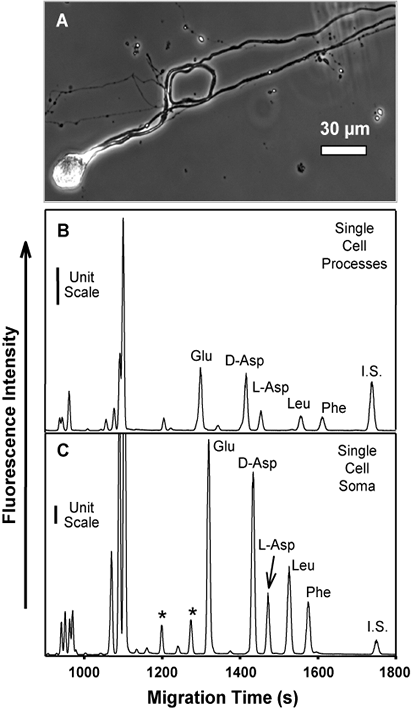
Besides well-known neurotransmitters such as serotonin and dopamine, amino acids underlie much of synaptic communication in our brain. Most research has focused on the role(s) that the more common l-enantiomers of amino acids play in neurotransmission and neuromodulation. However, recent findings indicate that several d-amino acids are present and involved in the mammalian brain and that changes in the levels of these amino acids coincide with the development of different diseases. Therefore, the neurochemistry of d-amino acids has become a new topic of interest to our group. In our experiments designed to uncover the functional roles of d-Asp and d-Glu in the brain, we use Aplysia californica.
While basic biochemistry textbooks state that in higher animals, the building blocks of life are l-amino acids, it appears that in the brain, there are exceptions. One established exception is the presence of the d-form of the amino acid serine (d-Ser), which modulates glutamate signaling. Our group and others have evidence for the presence of a second d-amino acid, d-Asp, in the nervous systems of a number of animals. Using a range of methods, we have shown that specific neurons can convert L-Asp to D-Asp and release this in a Ca-dependent manner, and we are currently measuring the electrophysiological effects of d-Asp. Lastly, we have found several neurons that have high levels of d-Glu, while its levels in the entire brain appear to be low, indicating it may be another relevant d-amino acid in the brain.
Understanding Serotonin Catabolism
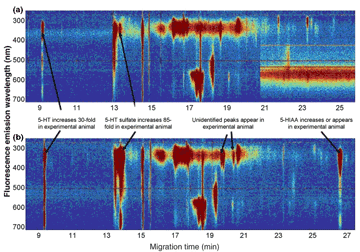
Serotonin (5-hydroxytryptamine, 5-HT) is a biogenic amine responsible for a variety of tasks in the nervous system. 5-HT is implicated in learning and memory in the central nervous system (CNS) and emesis and peristaltic reflex in the enteric nervous system (ENS), and even can act as a trophic factor during nervous system development. Several organs serve as targets for 5-HT, but the fate of 5-HT in target tissues, let alone the physiological effects of the resulting metabolites, has not been fully ascertained. We are characterizing the products of 5-HT and transformed 5-HT, as well as their distribution patterns in a range of models. Studies include changes in 5-HT levels, new 5-HT pathways and information on its catabolism during disease.
 What animal models do we use to study neuronal function? From "simpler" to "complex":
What animal models do we use to study neuronal function? From "simpler" to "complex":
- Mollusks with simple central nervous systems; ~10,000 larger neurons and a million synaptic connections
- Insects with social behaviors
- Mammals that are relevant to human disease and function